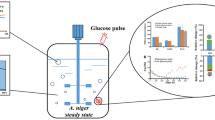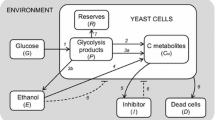Abstract
The influence of the composition of methanol/glucose-mixtures as only sources of carbon and energy on growth and regulation of the synthesis of enzymes involved in methanol-dissimilation was studied under chemostat conditions at a fixed dilution rate with the methylotrophic yeasts Hansenula polymorpha and Kloeckera sp. 2201. Both carbon sources were found to be utilized completely independently of the composition of the C1/C6 mixture. Using mixtures of 14C-labelled methanol and glucose the growth yield for glucose was found to be constant for all C1/C6-mixtures tested and both yeasts. The growth yield for methanol, however, was reduced by up to 25% when the proportion of methanol in the inflowing medium was lower than 20% (w/w with respect to glucose) for H. polymorpha and 50% (w/w with respect to glucose) for Kloeckera sp. 2201 respectively. During growth with C1/C6-mixtures containing higher C1-proportions of methanol regular growth yields for methanol were recorded which corresponded to the growth yields found with methanol as the only carbon source.
The regulation of the synthesis of the enzymes of the dissimilatory pathway for methanol was found to be under multiple control. Although glucose was present in the medium methanol had a positive effect on the synthesis of these enzymes. Thus, in addition to derepression induction by methanol was also observed. This inductive effect was found to increase with increasing proportions of methanol in the mixture. Depending on the enzyme, 10–40% methanol in the mixture resulted in a maximal induction with enzyme specific activities equal to those found in cells grown with methanol as the only carbon source. No further enhancements in enzyme specific activities were observed during growth on mixtures containing more than 40% methanol.
Similar content being viewed by others
Abbreviations
- C1 :
-
Methanol
- C6 :
-
glucose
- C1/C6 :
-
mixture compositions are given in % (w/w)
- C0 :
-
concentration of 14C in the inflowing medium (DPM ml-1)
- C(t):
-
concentration of 14C incorporated in cells as a function of time t (DPM ml-1)
- d :
-
dilution rate (h-1)
- DPM:
-
disintegrations per minute
- q s :
-
q C1 and q C6 are specific rates of consumption of substrate, methanol and glucose respectively [g (g cell dry weight)-1 h-1]
- q O2 and q CO2 :
-
are the specific rates of oxygen consumption and carbon dioxide release [mmol (g cell dry weight)-1 h-1]
- RQ:
-
respiration quotient (q CO2 q O2 -1)
- s C1 and s C6 :
-
are the residual concentrations of methanol and glucose in the culture liquid (g l-1)
- s O/C1 and s O/C6 :
-
are the concentrations of methanol and glucose in the inflowing medium (g l-1)
- Sp.A.:
-
enzyme specific activity
- x :
-
cell dry weight concentration (g l-1)
- Y X/C1 and Y X/C6 :
-
are growth yields on methanol and glucose respectively (g cell dry weight (g substrate)-1
- Y C/C1 :
-
growth yield with methanol with respect to carbon (g carbon assimilated (g carbon supplied)-1
- μm :
-
maximum specific growth rate (h-1)
References
Bull AT, Brown CM (1979). Continuous culture applications to microbial biochemistry. In: Quayle JR (ed) Internat. review of biochemistry, microbial biochemistry, Vol 21. University Park Press Baltimore, pp 177–226
Clarke PH, Lilly MD (1969) Regulation of enzyme synthesis during growth. Symp Soc Gen Microbiol 19:Cambridge University Press, pp 113–159
van dijken JP (1976) Oxidation of methanol by yeasts. Thesis. Univ Groningen, The Netherlands
van Dijken JP, Otto R, Harder W (1976) Growth of Hansenula polymorpha in a methanol-limited chemostat. Arch Microbiol 111:137–144
van dijken JP, Harder W, Quayle JR 91980) Energy transduction and carbon assimilation in methylotrophic yeasts. 3rd International Symposium on Microbial Growth on C1-Compounds. Sheffield
Dijkhuizen L, Harder W (1979) Regulation of autotrophic and heterotrophic metabolism in Pseudomonas oxalaticus OX1. Growth on mixtures of acetate and formate in continuous culture. Arch Microbiol 123:47–53
Eggeling L, Sahm H (1978) Derepression and partial insensitivity to carbon catabolite repression of methanol dissimilating enzymes in Hansenula polymorpha. Europ J Appl Microbiol Biotechnol 5:197–202
Eggeling L, sahm H (1980) Regulation of alcohol oxidase synthesis in Hansenula polymorpha: Oversynthesis during growth on mixed substrates and induction by methanol. Arch Microbiol 127:119–124
Egli Th (1980) Wachstum von Methanol assimilierenden Hefen. Eine Chemostat-Studie über die Regulation der Methanol dissimilierenden Enzyme. Dissertation No. 6538, ETH, Zürich
Egli Th, van Dijken JP, Veenhuis M, Harder W, Fiechter A (1980) Methanol metabolism in yeasts: Regulation of the synthesis of catabolic enzymes. Arch Microbiol 124:115–121
Egli Th, Fiechter A (1981) Theoretical analysis of media used in the growth of yeasts on methanol. J Gen Microbiol 123:365–369
Egli Th, Käppeli O (1980) Simultaneous utilisation of glucose and methanol in chemostat cultures of H. polymorpha and Kloeckera sp. 2201. 3rd International Symposium on microbial growth on C1-Compounds. Sheffield, U.K., Abstract, p 19
Fiechter A, von Meyenburg K (1968) Automatic analysis of gas exchange in microbial systems. Biotechnol Bioeng 10:535–549
Fukui S, Kawamoto S, Yasuhara S, Tanaka A, Osumi M, Imaizumi F (1975) Microbody in methanol-grown yeast. Localisation of catalase and flavin-dependent alcohol oxidase in the isolated microbody. Eur J Biochem 59:561–566
Gottschal JC, Kuenen JG (1980) Mixotrophic growth of Thiobacillum A2 on acetate and thiosulphate as growth-limiting substrates in the chemostat. Arch Microbiol 126:33–42
Harder W, Dijkhuizen L (1976) Mixed substrate utilisation. In: Continuous culture 6: Applications and new fields, Dean ACR, Ellwood DC, Evans CGT, Melling J (eds) Ellis Harwood Ltd. Chichester-Oxford: pp 297–314
Kato N, Tani Y, Ogata K (1974) Enzyme system for methanol oxidation in yeasts. Agr Biol Chem 38:675–677
Knöpfel HP (1972) Zum Crabtre-Effekt bei S. cerevisiae. Thesis. Nr. 4906, Zürich
Kornberg A, Horecker BL (1955) Glucose-6-phosphate dehydrogenase. In: Methods in enzymology, Colowick SP, Kaplan NO (eds) Vol.I. Academic Press Inc. Publishers, New York, pp 323–327
Lowry OH, Rosebrough NJ, Farr AL, Randall RJ (1951) Protein measurement with the Folin phenol reagent. J Biol Chem. 193:265–275
Lück H (1963) Catalase. In: Methods of enzymatic analysis, Bergmeyer HU (ed). Academic Press, New York London, pp 885–894
Melling J (1977) Regulation of enzyme synthesis in continuous culture. In: Topics in enzyme and fermentation biotechnology 1 (Wiseman A ed), Ellis Horwood Ltd, Chichester, pp 10–42
Metzenberg RL (1972) Genetic regulatory systems in Neurospora 3037. Ann Rev Genetics 6:111–132
Powell EO (1967) The growth rate of microorganisms as a function of substrate concentration. In: Microbial physiology and continuous culture. Proc. 3rd International Symposium on Continuous Culture of Microorganisms. Powell EO, Evans CGT, Strange RE, Tempest DW (eds). H.M.S.O. London, pp 34–55
Roggenkamp R, Sahm H, Wagner F (1974) Microbial assimilation of methanol. Induction and function of catalase in Candida boidinii. FEBS Lett. 41:283–286
Sahm H, Wagner F (1973a) Mikrobielle Verwertung von Methanol. Eigenschaften der Formaldehyddehydrogenase und der Formiatdehydrogenase aus Candida boidinii. Arch Mikrobiol 90:263–268
Sahm H, Wagner F (1973b) Methanol-Stoffwechsel der Hefe Candida boidinii. 3. Symposium Technische Mikrobiologie, Berlin, pp 367–373
Sahm H (1977) Metabolism of methanol by yeasts. In: Advances in biochemical engineering, Ghose TK, Fiechter A, Blakebrough N (eds) Springer, Berlin Heidelberg New York, pp 77–103
Schlanderer G, Held W, Reimann J, Dellweg H (1978) Metabolic changes during substrate shifts in continuous cultures of the yeast Candida boidinii variant 60. Eur J Appl Microbiol Biotechnol 6:133–144
Strøm, T, Ferenci T, Quayle JR (1974) The carbon assimilation pathways of Methylococcus capsulatus, Pseudomonas methanica and Methylosinus trichosporium (OB3B) during growth on methanol. Biochem J 144:465–476
Author information
Authors and Affiliations
Rights and permissions
About this article
Cite this article
Egli, T., Käppeli, O. & Fiechter, A. Regulatory flexibility of methylotrophic yeasts in chemostat cultures: Simultaneous assimilation of glucose and methanol at a fixed dilution rate. Arch. Microbiol. 131, 1–7 (1982). https://doi.org/10.1007/BF00451490
Received:
Accepted:
Issue Date:
DOI: https://doi.org/10.1007/BF00451490




